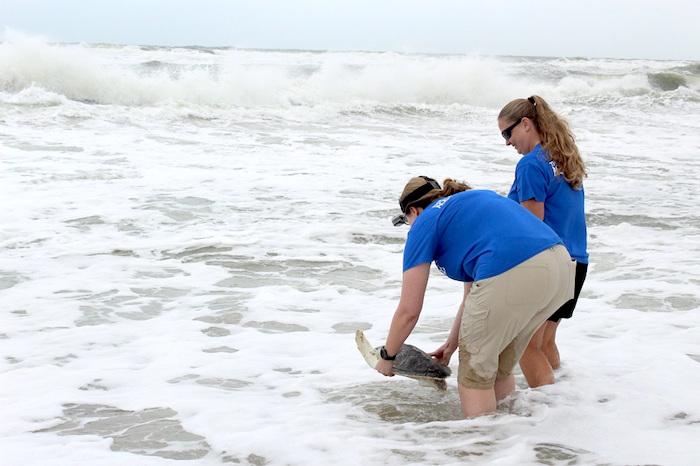
Cristy Barrett, associate curator, and Rebecca Hughes, education volunteer coordinator, from The Florida Aquarium release a Kemp's ridley sea turtle off Canaveral National Seashore in New Smyrna Beach on Wednesday, Oct. 18/ The Florida Aquarium
A juvenile Kemp's ridley sea turtle has been returned to the Atlantic Ocean at Canaveral National Seashore in Florida nearly a year after being shocked by a cold blast in New England that sent it to The Florida Aquarium to be nursed back to full health.
Carried into the surf at the seashore on Wednesday by an aquarium staffer, the 12-pound sea turtle quickly vanished into the water.
“It was such a joy to release this Kemps ridley today,” said Cristy Barrett, associate curator at The Florida Aquarium. "Although we experienced some heavy wind today, we are very happy that we were able to return one of the most endangered Florida sea turtles back to its natural environment."
Cold-stunning occurs when sea turtles are exposed to prolonged cold water temperatures. As cold-blooded reptiles that rely on external sources of heat to determine their body temperature, sea turtles do not have the ability to warm themselves in cold water.
“Initial effects of cold-stunning include decreased heart rate, decreased circulation and lethargy, which can then lead to shock, pneumonia and possibly death if not corrected,” explained Dr. Kathy Heym, director of Animal Health at The Florida Aquarium.
The New England Aquarium gave the turtle emergency medical care for two weeks before it was deemed fit for travel to a secondary rehabilitation facility.
The turtle was flown from Marshfield Massachusetts Airport to Tampa Executive Airport on Dec. 21, 2016, by pilot Chuck Yanke and co-pilot Mike Lalley, who volunteered their time and aircraft to transport 19 sea turtles that needed rehab, including this one, from New England to Florida.
The care of these turtles was then transferred to several facilities to continue their rehabilitation with the ultimate goal of release. The Florida Aquarium received 12 turtles, Clearwater Marine Aquarium received three turtles, and Sea World Orlando received four turtles.
Upon arrival at The Florida Aquarium, the turtle that was released Wednesday was alert but thin and not taking regular, deep breaths. Its blood results showed signs of infection, and it displayed evidence of pneumonia on X-rays, which is common in cold-stunned sea turtles. This turtle was treated with fluids initially until its appetite improved, as well as antibiotics to treat its pneumonia. This turtle also had a small, sensitive wound just beneath its nostrils that required frequent attention by the veterinary staff and topical medications to encourage healing.
“This turtle began to swim within days of its arrival at the aquarium and began eating well within the first two weeks. The abnormalities on blood work and X-rays associated with its pneumonia resolved after several months, and the chronic wound on its rostrum finally healed, as well. As part of this turtle’s pre-release evaluation, we tested its ability to catch and eat live food and determined that it was capable of doing so and is ready for release,” Dr. Heym said.
The Florida Aquarium’s sea turtle rescue and rehabilitation efforts are part of the organization’s Center for Conservation and is one of only a few rehabilitation facilities authorized by the Florida Fish and Wildlife Conservation Commission to treat sick or injured endangered sea turtles.
With an emphasis on critical care and release back into its natural habitat, The Florida Aquarium's full-time veterinary program and medical staff assist with sea turtle rehabilitation not only in Tampa, but nationwide. They do everything they can to ensure the conservation and ongoing livelihood of these amazing creatures.



Comments
Reading articles like this, where people work so hard to help our finned, furred and feathered friends, always renews my faith in what humanity can do to keep the environment and its denizens healthy.